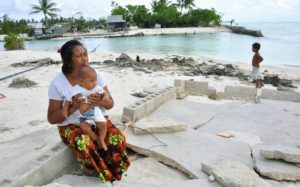Climate change driving mass migration – new reports
Climate change will soon become a massive driver of migration and dislocation, according to a raft of new research.
Experts say it is difficult to predict exactly how many people around the world will be forced to move as the effects of climate change grow starker in the coming decades.
But mass displacement is already happening as climate change contributes to natural disasters such as desertification, droughts, floods, and powerful storms.
 About 203 million people around the world were displaced by natural disasters between 2008 and 2015, and the risk has doubled since the 1970s, according to the Norwegian Refugee Council’s (NRC) 2016 Global Report on Internal Displacement.
About 203 million people around the world were displaced by natural disasters between 2008 and 2015, and the risk has doubled since the 1970s, according to the Norwegian Refugee Council’s (NRC) 2016 Global Report on Internal Displacement.
Most of the displacement takes place within countries, but those driven across borders are not considered refugees, because the 1951 Refugee Convention recognises only people fleeing war or persecution.
“There is a legal gap to assist and protect people who cross borders in the context of disasters and climate change,” the NRC report said.
It said another aspect of climate change, which makes it hard to quantify the exact number of people displaced by the phenomenon, is that it is a ‘threat multiplier’.
This means it exacerbates the potential for other drivers of forced migration such as conflict; so refugees fleeing war may also be fleeing climate change. It also often triggers slow-onset disasters like droughts, which gradually erode people’s livelihoods.
The numbers of people displaced by climate change will depend to a great degree on what countries do now to mitigate the future effects, the report says.
A recent global migration policy conference in Dhaka, Bangladesh, was told that “the international system is in a state of denial” over climate change and its effect on migration.
Mr A.N. Muniruzzaman, head the Bangladesh Institute for Peace and Security Studies, told the Global Forum on Migration that climate change figured as just a ‘sub-theme’ in most discussions about development and migration.
The conference was held less than two months after UN nation states committed to developing within two years a Global Compact on Safe, Orderly and Regular Migration.
“If we want an orderly management of the coming crisis, we need to sit down now – we should have sat down yesterday – to talk about how the management will take place,” Mr Muniruzzaman told the conference.
The UN’s refugee agency, UNHCR, and the International Organization for Migration, say they are aware of the risks, and are working to bring climate change to the forefront of policy discussions.
The head of UNHCR’s Asylum and Migration Unit Michele Cavinato described climate change “the defining challenge of our times”.
Bangladesh is fitting place to hold discussions on the risks of climate change.
The country’s 160 million people are squeezed into an area smaller than Tunisia, which has just 11 million people, making it one of the most densely-populated countries on earth.
Its coastline hugs the Bay of Bengal which is subject to tropical cyclones that are increasing in frequency and intensity.
Bangladesh is also one of the world’s lowest-lying countries, with a river delta comprising much of its territory and making it vulnerable to land erosion and flooding.
Himalayan glaciers are predicted to melt, swelling the rivers, while rising sea levels could engulf coastal areas and cause salinisation further inland, contaminating drinking water and rendering agriculture impossible.
Some predictions say that by 2050, Bangladesh could see more than 20 million people displaced.
The Bangladesh government’s own Climate Change Strategy and Action Plan predicts many displaced people will migrate to the capital, which will swell from 14 to 40 million people.
Bangladesh’s cities will not be able to absorb the influx of people driven from their homes by climate change.
“The settlement of these environmental refugees will pose a serious problem for… densely populated Bangladesh and migration [abroad] must be considered as a valid option for the country,” the plan says.
“Preparations in the meantime will be made to convert this population into trained and useful citizens for any country,” it says.
While Bangladesh will be one of the countries hardest hit by climate change, the issue is global.
Desertification is already consuming fertile land in Africa, causing people to leave their homes to find work elsewhere, including Europe. Some countries are predicted to disappear entirely into rising seas.
The Pacific Island nation of Kiribati has a strategy that would ideally allow 100,000 of its citizens to “migrate with dignity”.
However, South Asia, with its large population and vulnerability to various climate change effects, is particularly at risk, according to a new report by the International Organization for Migration (IOM).
Of the 203 million people internally displaced between 2008 and 2015 by natural disasters, 36 percent were in South Asia.
The report says that the South Asian Association for Regional Cooperation has recognised climate change as a threat, and made policies intended to mitigate the effects.
However, “migration concerns are only scantily mentioned”, according to the IOM report.
Laurie Nowell
AMES Australia Senior Journalist












